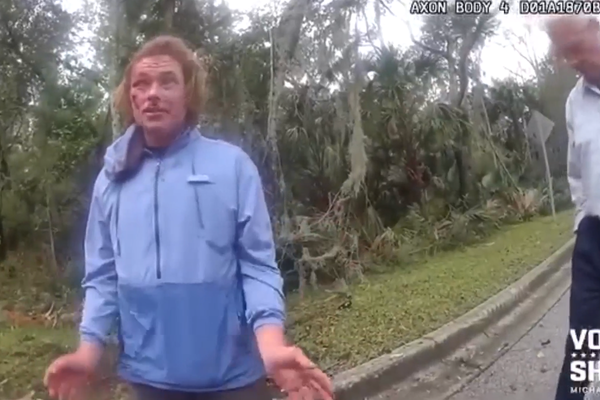
It was already chaos, and now, it was going to get worse. The US supreme court’s decision wasn’t exactly a surprise – everyone knew it was coming – but the rage in the room felt palpable. The language of the opinion had been taunting and cruel; the punishment from the court felt vindictive, personal. People were already dying for lack of access to healthcare; the ruling would push people in need even further to the margins. Now, the most vulnerable faced criminalization, harassment and even death, and for what? For the conservative Christian values that none of them had voted for? For a regressive, punitive, and cruel vision of gender and sexuality that most of the world had long since left behind?
The ruling was Bowers v Hardwick, and the year was 1987. The supreme court, in a virulently homophobic opinion, had upheld a Georgia law criminalizing gay sex between consenting adults. At the time, the Aids crisis was gripping gay America. Out of bigotry and indifference, both the federal government and the pharmaceutical sector were dragging their feet. Meanwhile, thousands of people, mostly gay men and IV drug users, were dying slow, painful, premature deaths, at the margins of a society that hated them and feared their disease.
The moral stakes couldn’t have been more clear: a backwards and oppressive understanding of gender was creating needless suffering and death. It wasn’t the birth of Act Up, the radical grassroots activist group that confronted the Aids crisis in America, but it was the moment when Act Up was energized into the powerful force it would become. At the group’s regular Monday night meetings at New York’s Lesbian and Gay Center, the crowd swelled with outraged queers ready to be organized.
The reproductive rights movement now faces a similar moment of rage and revival. Since the Dobbs opinion reversed Roe v Wade and eliminated the constitutional right to an abortion, there has been an outpouring of pro-choice sentiment from previously unorganized or apolitical citizens. Meanwhile, an onslaught of horror stories is pouring out from conservative states: miscarrying patients going into septic shock before they can be treated; women forced to carry dead or doomed fetuses for weeks; little girls, raped and impregnated by men they thought they could trust, fleeing their states to get the abortions that will allow them to reclaim what’s left of their childhoods. This is just the beginning: there will be more of these stories, many more, and they will get worse.
Like the gay community in 1987, American women are now faced with a moment of profound terror, anger, and grief whose full extent is yet to be seen. A slogan advanced in recent years by the pro-abortion group We Testify attempts to destigmatize the procedure: everyone loves someone who’s had an abortion. Soon, everyone will know someone who has needed an abortion, and struggled to get it.
Moments of feminist rage aren’t uncommon in American politics, but the ability to harness women’s anger for political ends has been a trickier feat, especially in recent years. The Women’s March, which followed Donald Trump’s election, drew in giant numbers for street protests, but was unable to harness its support toward a specific agenda. The organization was hobbled by infighting and lack of direction. Later, the #MeToo movement was able to generate public conversation and remove a number of high-profile abusers from positions of power. But #MeToo was not able to translate its moral authority into a political platform.
Act Up offers a different model, one with a proven record of success. Like feminists and abortion rights supporters now, Act Up was composed of people of varying backgrounds, commitments, and ideologies. They had different priorities, skills, and ideas; different perspectives and styles. But they all shared the same goal: to combat the Aids crisis, and to improve the lives of people with Aids.
The writer and teacher Sarah Schulman, an Act Up veteran, attributes the group’s success to “a strategy of difference facilitating simultaneity of response”. In other words, a lot of different kinds of people were using different tactics, all in pursuit of the same things. Under this broad but well-defined agenda, the group was able to transform its varied constituency into an asset – not a liability.
Over the five years that it was most active and influential, 1987-1992, the group was able to successfully lobby to lower drug prices, get more people included in trials, extend Aids benefits to women, and cut red tape to get more treatments to market. Their loud, aggressive, and irreverent public demonstrations at the FDA building and in the offices of pharmaceutical executives were carefully targeted and publicized, meant to garner publicity and also to be as uncomfortable and inconvenient as possible to the powerful people who were standing in their way. Now, the mainstream media scolds protesters for holding demure vigils outside the home of Brett Kavanaugh in Chevy Chase, Maryland. Back then, Act Up went down to DC to protest outside a politician’s home, too. They found out the address of the rightwing, anti-gay North Carolina senator Jesse Helms, and with the news cameras rolling, put a giant condom over his house.
Maybe one of the great lessons of Act Up is this willingness to embrace irreverence and joy, something the reproductive rights movement, to their great credit, have also embraced. But another virtue is that the group employed a multiplicity of tactics and responses while maintaining a singleness of purpose.
Feminism, as a movement, has long had a problem of unsustainably expanding responsibilities. Because women exist in all walks of life, any social problem can be cast as a feminist problem. But no movement can take on responsibility for every injustice in the world. Like Act Up, the reproductive rights movement would be wise to assign itself an expansive understanding of a narrow remit.
Act Up aimed to combat the Aids crisis and improve the lives of people with Aids, a purview that enabled different factions within the group to take on issues of drug access, housing discrimination, sex education, and the power of the Catholic church. Likewise, the reproductive rights movement would be wise to dedicate itself only to the emergency at hand: abortion access, and the lives of people who need abortions. It is there that they can do the most good for those affected, and it is where they can reshape, as Act Up did, both the public debate and the facts on the ground.
Much of this is already happening. In the years that the right has been ascendant and abortion supporters have been on the defensive, large, national non-profit advocacy groups have mostly been on the back foot. But in the places they have vacated, a vast network of small but mighty local organizations, and abortion funds, have stepped in to help those seeking abortions with material needs. These groups represent an essential intervention in material service provision. They can also form the foundation for what feminism needs now: an organized political movement.
Moira Donegan is a Guardian US columnist







